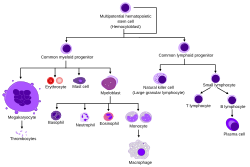This article may be too technical for most readers to understand. (August 2015) |
| Hematopoietic stem cell | |
|---|---|
 Overview of normal human haematopoiesis | |
| Details | |
| Precursor | Hemangioblast |
| System | Hematopoietic system |
| Location | Bone marrow |
| Function | Stem cells that give rise to other blood cells |
| Identifiers | |
| Latin | cellula haematopoietica praecursoria |
| Acronym(s) | HSC |
| MeSH | D006412 |
| TH | H2.00.01.0.00006 |
| Anatomical terms of microanatomy | |
Hematopoietic stem cells (HSCs) are the stem cells[1] that give rise to other blood cells. This process is called haematopoiesis.[2] In vertebrates, the first definitive HSCs arise from the ventral endothelial wall of the embryonic aorta within the (midgestational) aorta-gonad-mesonephros region, through a process known as endothelial-to-hematopoietic transition.[3][4] In adults, haematopoiesis occurs in the red bone marrow, in the core of most bones. The red bone marrow is derived from the layer of the embryo called the mesoderm.
Haematopoiesis is the process by which all mature blood cells are produced. It must balance enormous production needs (the average person produces more than 500 billion blood cells every day) with the need to regulate the number of each blood cell type in the circulation. In vertebrates, the vast majority of hematopoiesis occurs in the bone marrow and is derived from a limited number of hematopoietic stem cells that are multipotent and capable of extensive self-renewal.
Hematopoietic stem cells give rise to different types of blood cells, in lines called myeloid and lymphoid. Myeloid and lymphoid lineages both are involved in dendritic cell formation. Myeloid cells include monocytes, macrophages, neutrophils, basophils, eosinophils, erythrocytes, and megakaryocytes to platelets. Lymphoid cells include T cells, B cells, natural killer cells, and innate lymphoid cells.
The definition of hematopoietic stem cell has developed since they were first discovered in 1961.[5] The hematopoietic tissue contains cells with long-term and short-term regeneration capacities and committed multipotent, oligopotent, and unipotent progenitors. Hematopoietic stem cells constitute 1:10,000 of cells in myeloid tissue.
HSC transplants are used in the treatment of cancers and other immune system disorders[6] due to their regenerative properties.[7]
- ^ Monga I, Kaur K, Dhanda S (March 2022). "Revisiting hematopoiesis: applications of the bulk and single-cell transcriptomics dissecting transcriptional heterogeneity in hematopoietic stem cells". Briefings in Functional Genomics. 21 (3): 159–176. doi:10.1093/bfgp/elac002. PMID 35265979.
- ^ Birbrair A, Frenette PS (April 2016). "Niche heterogeneity in the bone marrow". Annals of the New York Academy of Sciences. 1370 (1): 82–96. Bibcode:2016NYASA1370...82B. doi:10.1111/nyas.13016. PMC 4938003. PMID 27015419.
- ^ Dzierzak E, Bigas A (May 2018). "Blood Development: Hematopoietic Stem Cell Dependence and Independence". Cell Stem Cell. 22 (5): 639–651. doi:10.1016/j.stem.2018.04.015. hdl:10230/36965. PMID 29727679.
- ^ Ottersbach K (April 2019). "Endothelial-to-haematopoietic transition: an update on the process of making blood". Biochemical Society Transactions. 47 (2): 591–601. doi:10.1042/BST20180320. PMC 6490701. PMID 30902922.
- ^ Till JE, McCULLOCH EA (February 1961). "A direct measurement of the radiation sensitivity of normal mouse bone marrow cells". Radiation Research. 14 (2): 213–22. Bibcode:1961RadR...14..213T. doi:10.2307/3570892. hdl:1807/2781. JSTOR 3570892. PMID 13776896.
- ^ "5. Hematopoietic Stem Cells". Stem Cell Information. National Institutes of Health, U.S. Department of Health and Human Services. 17 June 2011. Archived from the original on 2015-09-29.
- ^ Müller, Albrecht M.; Huppertz, Sascha; Henschler, Reinhard (July 2016). "Hematopoietic Stem Cells in Regenerative Medicine: Astray or on the Path?". Transfusion Medicine and Hemotherapy. 43 (4): 247–254. doi:10.1159/000447748. ISSN 1660-3796. PMC 5040947. PMID 27721700.